-
Research
-
Production
-
Who and Where
- Opportunites
Conférence grand public "Estimer son empreinte carbone. Pourquoi ? Comment ?" 7/2023 , Institut d'Étude Scientifique de Cargèse replay (malheureusement hébergé par un gafam)
actualité de CNRS-Ingénierie 17 nov 2025 [an highlight for PNAS 122 (27) e2426598122 (2025)
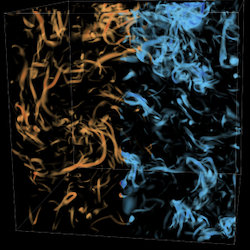
Zones de forte vorticité dans la turbulence d’hélium superfluide (obtenues par simulation numérique directe). Aux échelles illustrées, les deux composantes développent quasiment les mêmes structures tourbillonnaires, malgré leurs propriétés différentes. Dans le superfluide (à droite), ces structures résultent de l’agrégation de vortex quantiques à très petite échelle. Par friction mutuelle, ces paquets de vortex entraînent la formation de structures tourbillonnaires similaires dans le fluide normal (à gauche). © J. I. Polanco et al
Près du zéro absolu, l’hélium perd sa viscosité et devient superfluide. S’il se comporte encore en partie comme un fluide classique, l’émergence de vortex quantiques modifie sa dynamique. Des scientifiques ont proposé une description théorique originale de la turbulence dans l’hélium superfluide. Publiée dans la revue PNAS, cette étude unifie de nombreux résultats expérimentaux et numériques antérieurs, et apporte un éclairage nouveau sur les propriétés de ces écoulements.
L’hélium liquide devient superfluide, c’est-à-dire presque dépourvu de viscosité, à des températures inférieures à 2,17 K. Dans cet état, il présente également une conductivité thermique exceptionnelle, exploitée notamment pour refroidir les bobines supraconductrices des accélérateurs de particules, comme au CERN, ou les capteurs embarqués dans certains satellites. Lorsque l’écoulement devient turbulent, la dynamique de l’hélium superfluide s’apparente, à grande échelle, à celle d’un fluide classique. En revanche, la dynamique à petite échelle demeure moins bien comprise. À l’échelle d’une dizaine de microns, on observe l’apparition de vortex quantiques dont le cœur est réduit à un seul atome. L’hélium superfluide est alors communément décrit comme la coexistence de deux composantes en interaction : une composante visqueuse classique (appelée fluide normal) et une autre sans viscosité dotée de vortex quantiques (appelée superfluide). Les caractéristiques de ce mélange varient fortement entre 1 et 2,17 K, ce qui suggère que les propriétés de la turbulence qui en résulte dépendent non seulement des échelles spatiales mais également de la température.
En repartant des équations maîtresses de la mécanique des fluides et en s’appuyant sur des simulations numériques, des chercheurs et une chercheuse du Laboratoire de mécanique des fluides et d’acoustique (LMFA, CNRS/Centrale Lyon/Univ. Claude Bernard Lyon 1/INSA Lyon), du Laboratoire des écoulements géophysiques et industriels (LEGI, CNRS/Univ. Grenoble Alpes/Grenoble INP), de l’Institut Néel (CNRS/Univ. Grenoble Alpes) et du laboratoire Morphodynamique continentale et côtière (M2C, CNRS/Univ. Rouen Normandie/Univ. Caen Normandie) ont développé une description théorique originale de la turbulence quantique, permettant de distinguer les effets liés à la température de ceux induits par le nombre de Reynolds, nombre sans unité qui caractérise le niveau de turbulence d’un fluide. L’idée de départ a été de traiter les deux fluides comme s’ils n’étaient qu’un seul fluide effectif, ce qui a permis de généraliser les outils théoriques couramment employés pour la description des fluides classiques. Résultat marquant, cette approche conduit à une loi quantitative reliant la densité de vortex quantiques au nombre de Reynolds. Cette loi, qui établit un lien entre les propriétés quantiques de l’hélium superfluide et sa dynamique macroscopique turbulente, montre un excellent accord avec la quasi-totalité des mesures expérimentales disponibles à ce jour. Plus généralement, ces travaux proposent un cadre théorique robuste permettant de mieux décrire la turbulence dans l’hélium superfluide. Les scientifiques veulent à présent continuer d’étudier les petites échelles, en s’attachant à la dynamique des vortex quantiques.
written by E. Woillez [an highlight for EPL 134:46002 (2021)]
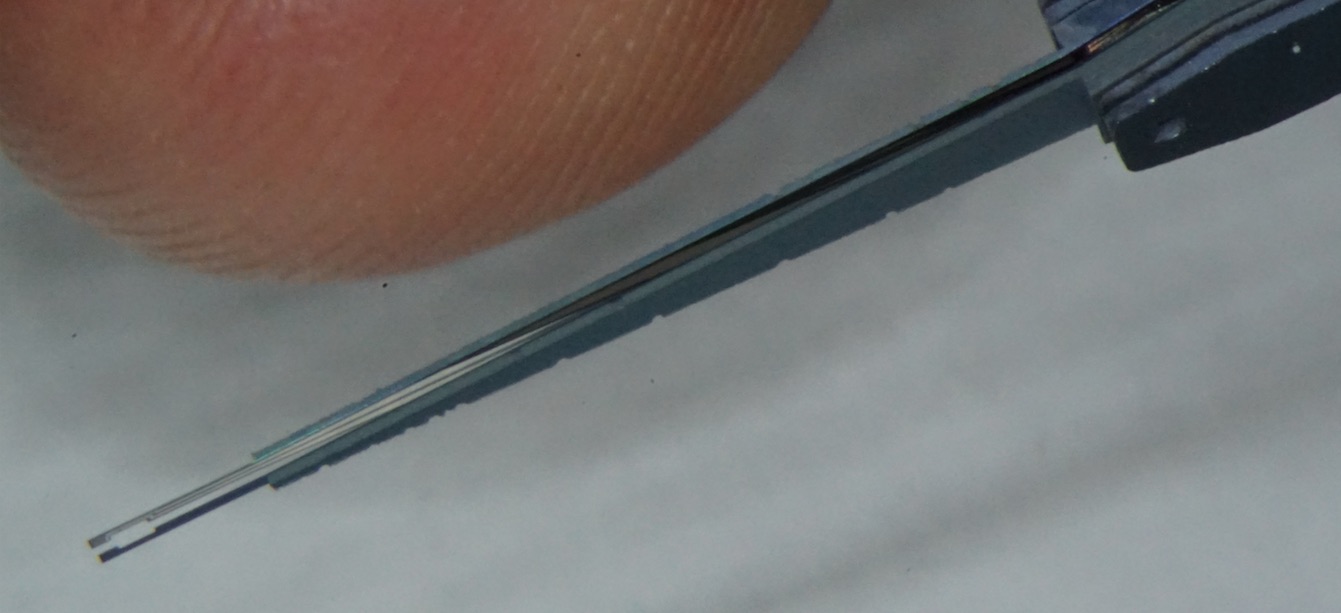
A 250 microns size second sound tweezers
Quantum turbulence displays the spectacular property to dissipate energy without viscosity. This process is intimately related to the dynamical structure of the flow at very small scale. Existing velocity sensors are too large to resolve the crossover scale between classical and quantum physics. The propagation of temperature waves called “second sound” is an alternative way to directly probe the quantum scales of the flow. Using micro-fabricated second sound tweezers, researchers from Institut Neel report the first characterization of quantum scale fluctuations in intense turbulent flows, close and far below the superfluid transition.
based on [J. Bertolaccini et al, PRF 2:123902 (2017) ]
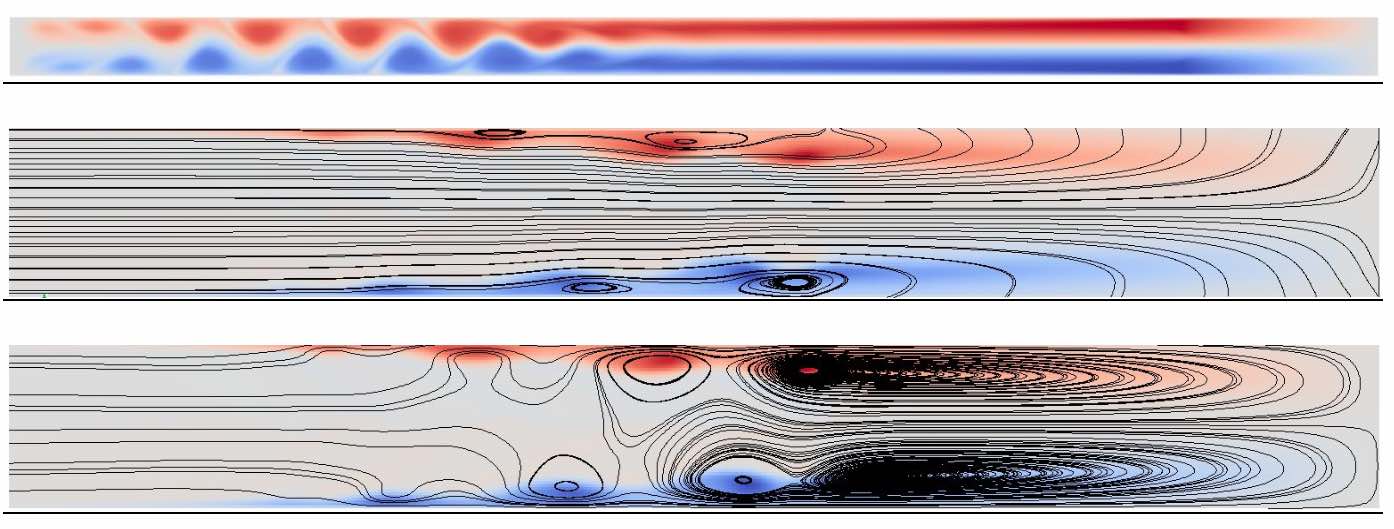
Effect d'entrée d'un écoulement superfluide
Un sillage turbulent est d’autant plus étendu que la viscosité du fluide est faible. Des simulations d’un écouleent sans viscosité d’hélium superfluide révèlent un subtil effet de sillage permettant d’expliquer de nombreuses expériences contradictoires.
Après sa rencontre avec les piles d’un pont, une rivière présente une turbulence sur la suite de son parcours. Ce sillage est la mémoire des perturbations subies en amont, près des piles. Cette mémoire s’estompe sur une distance d’autant plus grande que la viscosité du fluide est faible. Qu’en est-il d’un écoulement à viscosité nulle, pour un superfluide ?
L’étude des écoulements superfluides est devenue accessible aux physiciens à partir des années 1930 en utilisant de l’hélium liquide à des températures proches du zéro absolu (-273 °C). Cependant, les nombreuses expériences menées ont conduit à une grande disparité des mesures, souvent inconciliables. En s’appuyant sur des simulations numériques, on vient de découvrir un effet mémoire insoupçonné dans les écoulements superfluides. Ainsi, seules les mesures effectuées dans des conduites suffisamment longues peuvent être réconciliées, alors que les autres mesures sont inévitablement entachées d’effets mémoire relatifs aux conditions de démarrage de l’écoulement. Cette découverte a été parfaitement corroborée par l’analyse détaillée des conditions expérimentales des études précédentes, et permet désormais de mieux définir le dimensionnement des futures expériences sur les superfluides, et d’espérer (enfin) comprendre les mystérieuses instabilités de ces écoulements. En ingénierie, les écoulements superfluides jouent un rôle essentiel dans le refroidissement des bobines supraconductrices.
by Anaïs Schaeffer [CERN Bulletin Issue No. 32-33/2015]
Monday 3 August 2015
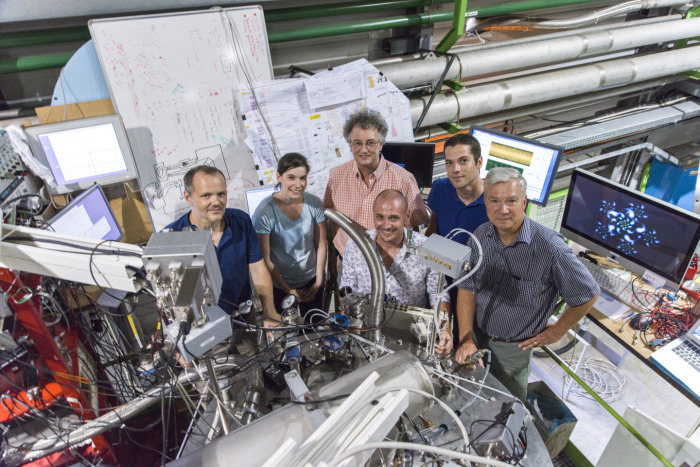
Fig.: The last day of data collection, July 2015.
As a member of the EuHIT (European High-Performance Infrastructures in Turbulence) consortium, CERN is participating in fundamental research on turbulence phenomena. To this end, the Laboratory provides European researchers with a cryogenic research infrastructure, where the first tests have just been performed....
CERN has a unique cryogenic facility in hall SM18, consisting of 21 liquid-helium-cooled test stations. While this equipment was, of course, designed for testing parts of CERN's accelerators, it can also be used for other laboratory experiments, notably for studying “very intense turbulence” in fluids.
Very intense turbulence is a natural phenomenon observed in numerous situations – in the atmosphere and in the ocean, in the slipstream of planes and trains, and even in stars – but it is very difficult to study. (to continue)
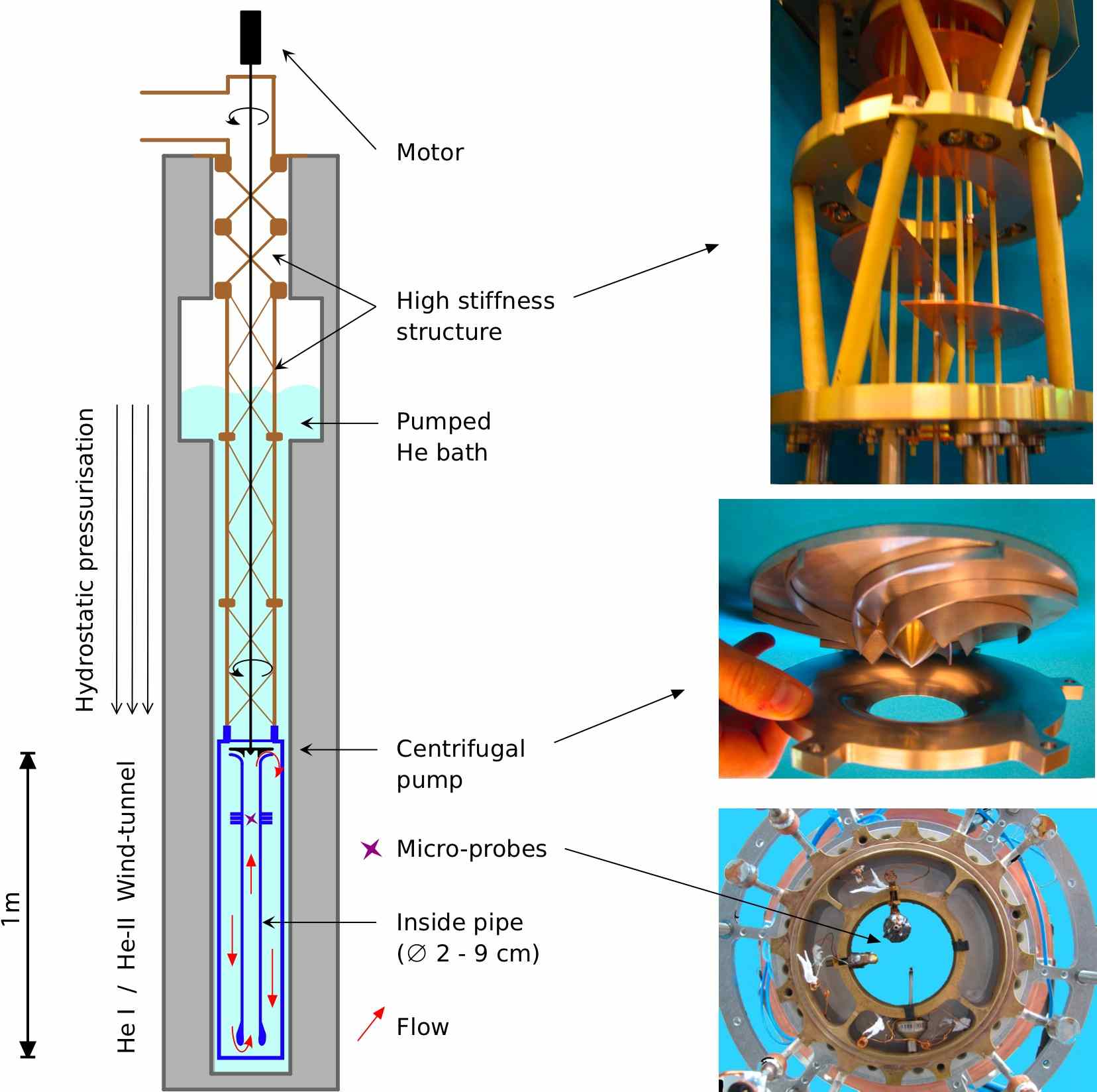
Fig. The TOUPIE wind-tunnel. At right: details of the high-stiffness, low-conductivity mechanical structure (top); cryogenic propeller specially optimised for liquid helium (middle); and probe holders with miniature Pitot-tube velocity sensors (bottom).
Stirring a honey pot with a spoon is awkward because the fluid viscosity damps the flow very efficiently. By contrast, in a less viscous fluid such as coffee in a cup, a slight movement of a spoon will generate eddies of different sizes. If the fluid is even less viscous, or if the mechanical stirring is more intense, a hierarchy between eddies of different sizes appears: the flow is turbulent. In 1941, the Russian mathematician Andrei Kolmogorov described this hierarchy of eddies with the image of an energy cascade : mechanical stirring feeds the largest eddies, which transfer their energy to smaller eddies and so on until the viscosity effectively inhibits any further whirling motion and dissipates energy into heat.
What does this cascade of energy become in a fluid with zero viscosity ? An exotic liquid allows us to address this question experimentally : superfluid helium. Below 2.17 K, liquid helium enters a quantum phase, the "He-II" state. It then acquires the remarkable capability of flowing without experiencing any viscosity. Exploring the turbulent cascade of a superfluid, however, raises two experimental challenges: creating a suitable cryogenic flow and probing the velocity fluctuations in the superfluid.
To answer these questions, the Institut Néel has developed a cryogenic "wind tunnel". We have named this apparatus "TOUPIE" (our acronym for “TOUrne Par l’Intérieur et l’Extérieur”, refering to the rotational degrees of freedom in the design of the experiment, and also the French word for a spinning top). It produces a closed, permanent flow of liquid helium along a record path of 2 metres (see Fig. 1) at temperatures from 4 K down to 1.5 K. It can operate with superfluid helium (He-II), and also with "viscous" liquid helium (the "He-I" state, above 2.17 K), thereby allowing direct comparison between the two cascades. The second challenge was to improve significantly the spatial resolution of the best probes for measuring velocity in a superfluid. Among the innovative sensors devised and developed, the one shown in Fig. 2 is a micro-machined silicon cantilever, coupled to an ultra-sensitive superconducting resonator diverted from its original astrophysics destination: the detection of cosmic particles.
The combination of this unique cryogenic wind tunnel with the smallest superfluid probes allowed us to compare the turbulent cascades of a classical fluid with those of a superfluid, with an unprecedented resolution. In particular, we found the first direct evidence that superfluid eddies can cascade from large to small scales in a fashion similar to that of classical eddies. This evidence came from the Kármán-Howarth "4/5 law", the only exact relation in turbulence (named after a factor 4/5 in the equation that relates the amount of energy carried by the turbulent cascade and a dissymmetric statistics of the velocity gradients). Comparing our data with the Kármán-Howarth law, we found that this law remains valid in a superfluid.
The next challenge is to understand how, in the superfluid, a non-viscous dissipation process replaces the effects of viscosity, especially in the limit of relatively low temperatures (~ 1 K). A second version of the TOUPIE wind-tunnel is in preparation to reach this lower temperature range.
Local velocity probe for cryogenic helium
[ Renatech newsletter, June 2011 ]
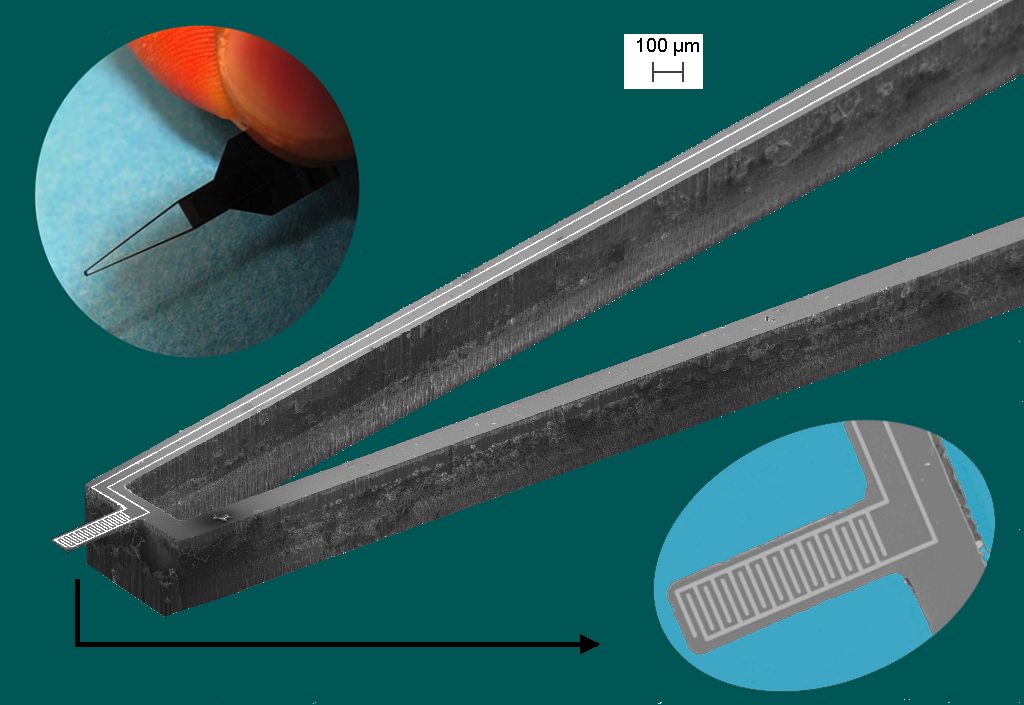
Fig. Micro-machined velocity probe based on the deflection of a 1 micron thick, 100 micron wide, silicon cantilever by the moving fluid. Main image shows the V-shaped probe-holder with the cantilever at its tip. The upper insert shows a general top-view onto the probe holder. The bottom insert is a zoomed top-view of the cantilever itself, carrying a circuit which is part of a superconducting resonator whose frequency varies with the cantilever's deflection. Device fabricated at Grenoble's Plateforme Technologique Amont.
The experimental study of superfluid turbulence, ie. the hydrodynamics of strongly stirred liquid helium at very low temperature (T < 2.17 K) requires specifically designed local probes. These probes need to be both very small and highly sensitive to measure the small scale velocity fluctuations that are fast and have a low amplitude.
To do this, we designed a cryogenic velocity probe based on a cantilever. The sensitive element of the probe is the cantilever tip (300 µm long, 100 µm wide, 1 to 10 µm thick), etched in a bulk silicon wafer using fluoride Deep Reactive Ion Etching. This tip is immersed in the bulk of a flow and gets deflected by the incoming fluid. The amplitude of this deflection is proportional to the square of the flow velocity in the vicinity of the cantilever tip. A precise measurement of the deflection fluctuations is achieved using a radio-frequency superconducting niobium LC resonator sputtered on the tip whose resonance frequency shifts when the cantilever is elongated.
This technique prevented us to allow the presence of any disordered dielectric material on the sample because they would lead to phase noise of the LC resonator. This precluded us from using an oxide barrier layer. Therefore we had to devise a way to properly tune the thickness. We used the etching machine refrigerating helium leak rate as an progress indicator. The first prototype has been cooled down and tested recently and showed good performances, similar to these of the best probes known to work in superfluid helium, and we believe that we can improve them even further in a near future.

Modélisation et simulation des écoulements de contre-courant de l’hélium superfluide par la méthode
Boltzmann sur réseau
Jonathan BERTOLACCINI, PhD thesis of ENS de Lyon
In co-direction with E. Lévêque, who was the lead advisor
9/2012-17/12/2015
archive TEL
Quantum turbulence versus Classical turbulence
Julien SALORT, PhD thesis of Grenoble university
9/2008-16/11/2011
archive TEL
Convection turbulente dans une cellule de Rayleigh-Bénard cryogénique : de nouveaux éléments en faveur du Régime Ultime de Kraichnan, PhD thesis of the Université Joseph Fourier
Frédéric GAUTHIER
9/2005-8/12/2008
archive TEL
High cryogenic Reynolds experiment : GReC
Sylvain PIETROPINTO, PhD thesis of the Université Joseph Fourier
9/1998-7/2002
Turbulent convection in cryogenic Rayleigh-Bénard cells
Philippe-E. ROCHE, PhD thesis of the Université Joseph Fourier
1/1998-1/2001
archive TEL
Towards dissipative scales in a gaseous Helium jet at low temperature
Olivier CHANAL, PhD thesis of the Université Joseph Fourier
1/1995-3/1998
Etude du régime turbulent en convection de Rayleigh-Bénard dans l'hélium liquide ou gazeux autour de 5 K
Xavier CHAVANNE, PhD thesis of the Université Joseph Fourier
1994-1997
Turbulence dans un jet d'hélium à basse température>
Antoine NAERT, PhD thesis of the Université Joseph Fourier
1995
Etude de la turbulence dans un jet d'hélium gazeux à basse température
Benoit CHABAUD, PhD thesis of the Université Joseph Fourier
1992